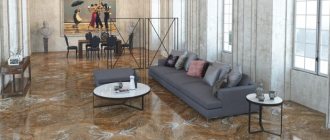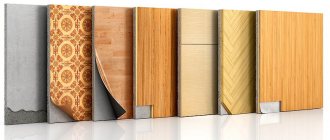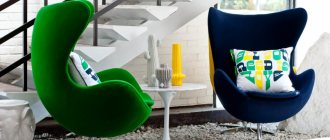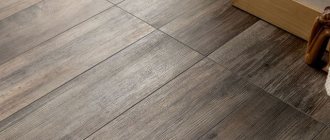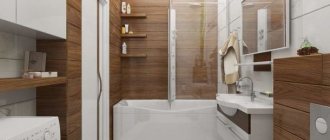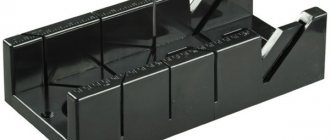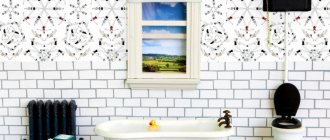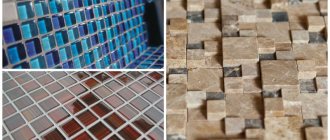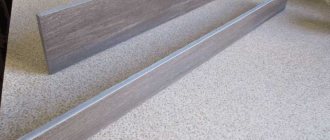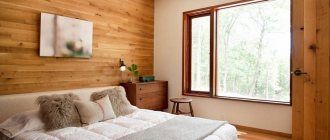Unusual design of ordinary tiles
A person always wants more. The tiles have moisture and wear resistance, natural wood has beauty, pleasant warm shades and a unique texture pattern.
Wooden floors and parquet are beautiful, but they are susceptible to dampness, fungus and bark beetles. They are wiped clean, they need to be periodically painted, varnished or impregnated with oil. And sometimes grind and scrape. The tile does not require painting or sanding, is easy to clean and lasts for several decades.
That's why people created facing tiles with a pattern that exactly imitates the pattern, warm, unique color and texture of natural wood.
Advantages of porcelain stoneware
The advantage of porcelain tiles is that they look very respectable . The material is excellent for decorating various rooms; the advantages are largely explained by the very properties of porcelain stoneware. This is a homogeneous material that does not have natural voids or cracks, nor does it contain any inclusions uncharacteristic of wood.
This material has enough advantages, the main advantages include:
- Moisture resistance, water is not absorbed, which a wooden floor cannot boast of;
- Durability. Porcelain tiles are not subject to mechanical stress, abrasion and scratches;
- The tiles can be used along with the heated floor system;
- Huge selection of textures, colors and shapes. It is possible to recreate almost any pattern on the surface;
- Hardness and easy maintenance;
- Resistance to temperature changes.
The peculiarity of using tiles under parquet is that they are laid with minimal seams. Available in rectangles or squares, which in some cases allows you to completely avoid the appearance of visible seams. Ceramic parquet is thick and massive and is usually used for flooring.
The use of porcelain stoneware allows you to visually expand a limited space; for this you should choose products in light colors - linden, pine, teak or birch. For a hallway, dark oak or stained wood tiles would be an excellent solution. It is even possible to combine natural parquet with porcelain stoneware. To do this, it is important to take into account some of the nuances of such a neighborhood:
- Select materials that are closest in texture and color;
- Create an ideal floor level so that the transition is not noticeable;
- First, artificial tiles are installed, then natural ones;
- When organizing work, you should check the horizontal positioning;
- At the border of the transition of materials, a plinth adapter is laid.
When installing tiles, the rough surface is carefully leveled; a flat surface will allow for a better fit of the individual elements to each other.
Advantages
Why do people choose ceramic tiles instead of planks or parquet? Advantages of wood-look tiles:
- resistance to water. The tile does not get wet, does not swell, does not change its shape, and does not deteriorate under the influence of water. The tiles are not affected by hot water in the bathhouse and bathroom, they do not absorb moisture and do not freeze or burst in the cold;
- Fungi and mold do not grow inside the tiles, and bark beetles do not eat them. Even if bluish spots of mold appear on the tile, it is enough to wash it even with clean water, and the mold will be washed off;
- High-quality laid tiles on the floor last for decades - they do not wear out or crack. Wall tiles that do not experience constant dynamic loads can last 100 years or more. The service life of wood on the floor is significantly shorter;
- properly chosen tiles are non-slip and therefore safe material. This quality is especially important for wet rooms - baths, bathrooms, terraces, porches. Painted or varnished wood is slippery;
- Easy to clean, you can use detergents. It is quite difficult to wash wooden floors - only with a semi-dry cloth and no aggressive detergents;
- resistant to aggressive environments and organic contaminants. It is easy to wipe off felt-tip pen, wine, beet juice and even nail polish and oil paint;
- tiles are cheaper than high-quality parquet and especially parquet boards;
- tiles are easier and cheaper to lay;
- conducts heat much better than wood, so it is indispensable when using a “warm floor” heating system;
- more practical to maintain - it does not require periodic scraping, sanding and painting.
Selection of colors for wood
Modern flooring material with imitation wood can be found in a wide range of any color, shade, shape. Products can be matte or polished, in almost all possible textures, they can imitate decorative, piece and artistic parquet, as well as laminate, solid wood, etc. In a modern, bright interior, flooring under a parquet board in the color “milk oak” or “wenge” will look ideal.
If this is required for the overall style decision, then you can easily choose the opposite option and opt for a material that imitates antique surfaces.
The maximum resemblance to real wood is obtained by using porcelain tiles with a textured coating. You can create texture by structuring, when the material takes the form of a press impression taken from real boards or parquet-type coverings. A more pronounced shade can be imparted during glazing, and believe me, such a floor covering will look almost 1 in 1.
Flaws
All materials have disadvantages. The main disadvantage of tiled flooring is that without heating, the tiles are cold to the touch. Wood is warmer and more pleasant to the touch.
The second drawback is that ceramics are quite fragile and require careful handling during transportation, unloading, carrying and laying. And the floor covering must be laid on a continuous layer of glue, otherwise it may crack from uneven load.
Types of tile surface
Regular tiles have several types of surface:
- matte - has a non-slip surface, does not shine, imitates wood very well and looks very prestigious;
- with a surface covered with glaze – the glaze is shiny and has very high strength and wear resistance;
- with a glossy surface – a shiny floor can visually enlarge a room;
- with a relief surface - these non-slip tiles are specially designed for tiling floors in wet rooms - bathrooms, saunas, toilets, kitchens.
Creating floor markings
In order for the installation to proceed, as they say, “without a hitch,” it is necessary to correctly mark the base. You cannot make mistakes, as tiles laid askew will not look attractive. You cannot show such a surface to your friends or in a photo, since the poor quality of the work performed will be immediately visible.
This procedure must be performed in a certain sequence:
- Finding the center of the room. For many laying schemes, this point will be the center of symmetry, which means that the tiles will be glued to the sides of it. Sometimes it is necessary to move the center a little to the side so that it coincides with the center of the front door. Such a decision can only be made by a specialist who understands what he is doing.
- To make the installation process comfortable, you can make parallel markings. To do this, you need to prepare a rope with blue and use it to draw several parallel lines at a distance equal to one side of the tile. Further installation can be done along such wide strips. The places where lines need to be drawn can be determined by first laying out the tiles without gluing them. This will greatly facilitate the work process in the future.
Porcelain tiles
Porcelain tiles are made at high pressure and temperature. Its strength far exceeds the strength and abrasion resistance of ceramic clay tiles.
A type of porcelain tile with increased thickness is produced, intended for installation in public buildings with high traffic - for example, shopping centers, train stations, airports.
The price of porcelain tiles is higher than the price of wood-effect tiles, but the quality of porcelain tiles more than makes up for the difference. Dimensions of porcelain stoneware tiles: from 15x15 cm to 60x60 cm; from 15x30 cm to 40x120 cm.
What is wood-look porcelain tile
Porcelain tiles do not lose their relevance due to their excellent technical characteristics. The production of this material is long and complex, but the result is products that differ little in appearance from natural materials. Most often they produce porcelain floor tiles with wood imitation.
Floor porcelain tiles are usually made from feldspar, several types of clay, quartz sand and coloring elements. Before use, the materials are processed, ground and mixed, resulting in a homogeneous mass that retains its color for a long time.
Then the mass is pressed using special equipment; this process consists of two stages. At the second stage, a pigmented layer is applied, which allows you to obtain an imitation of natural materials - wood, marble, precious stones; the imitation options can be clearly seen in the photo.
Subsequently, the products are fired in a special furnace at high temperatures, under their influence the mass melts, chemical reactions make it possible to obtain strong products that will last for decades. Finally, the tiles are polished, sorted and quality controlled.
Ceramic granite with wood texture imitates in detail a certain structure of wood. It can be used in different styles, from classic, Provence and country to loft or hi-tech styles.
Porcelain stoneware is an excellent solution for flooring; it can be used in various rooms, from living rooms to verandas, kitchens, terraces and corridors. The main advantage is that it does not absorb water, which allows it to be used for organizing floors in bathrooms and other rooms where exposure to moisture is high. In this case, not only the floor, but also the walls can be tiled. Even in such premises they will last for many years.
It has become popular to use porcelain tiles for finishing floors in public places - cafes and restaurants, shopping centers. In this case, it is more advisable to select a material with a corrugated surface, which is polished and glazed. This increases the wear resistance of the imitation.
The material has also been used in the design of stairs; it looks very original and makes it possible to create different types of steps that will stand out from the general background. Porcelain stoneware is also used for finishing outdoor areas.
PVC covering
This type of flooring has been produced for half a century. They just started making imitation wood from polyvinyl chloride recently. Often, a pattern imitating parquet is applied to PVC plates. Although the tiles do not have the hardness of ceramics, PVC is very durable and wear-resistant - the tiles will last at least 20 years (and even more). Plus - the tiles are pleasant and warm to the touch.
Note!
Floor tiles | Examples of using expensive and inexpensive floor tiles in interior design- Tile design - exclusive options and ideas | See the latest and most fashionable solutions here!
White tiles | The best interior solutions in real interiors and beautiful projects using white tiles
Form
The design of wood-look tiles can be very different. The shape of the tiles is rectangular, square, very elongated - narrow and larger. There are hexagonal tiles, with cut corners and even diamond-shaped ones. You can choose to suit every taste.
Most often, they use either tiles that imitate a short board, or long narrow tiles that are laid in the form of parquet.
How to choose
When choosing a facing material, you must first take into account the size of the room that will be covered. The smaller the room, the smaller the plates you need to use. Tiles of small and medium size (with a side of 5 to 30 cm) are used in bathrooms, corridors, toilets and small kitchens.
In more spacious living rooms and bedrooms, tiles up to 30 cm wide and up to 60 cm long are used - an exact imitation of a board. The installation is called “deck”. Sometimes rectangular tiles are laid, imitating a parquet pattern - “herringbone”, “checkerboard”, “braid”, “well”.
When choosing the size of the covering elements, you need to take into account that small elements are more difficult to lay, and large “board” plates in a small room look awkward and inharmonious
Note!
Stone-look tiles: examples of the perfect combination in the interior. Review of new designs using stone-look tiles (120 photos of new products)How many tiles are in a package: typical sizes and standard quantities of tiles from different manufacturers
Tile from A to Z: how to choose and use for tiling different rooms (180 photos of ideas and options)
When ceramics on the floor are a necessity
If the room has a “warm floor” heating system, then a ceramic coating on the floor is a conscious necessity. Many people do not like tile flooring in living rooms and kitchens - it visually seems “cold” and resembles public and office spaces.
For such people, wood-look floor tiles are simply an ideal material - they don’t hurt the eyes, and the floor does not interfere with the heating function of the house.
The tile conducts heat well. If you cover the floors with wood, carpet, or parquet, the efficiency of the heating system decreases by 10 or even 15%.
Advantages and disadvantages
Wood is a traditional, natural and beautiful material used to decorate walls and floors. The use of wood-look porcelain tiles allows you to create an original interior that combines the decorative effect of a wood surface and ease of maintenance. The texture, pattern and embossing can almost completely imitate a parquet board.
Advantages of porcelain stoneware
Wood-effect tiles are often used to create the design of a modern room. Due to its reasonable cost, it enjoys well-deserved popularity. The advantages of using this material include:
- Resistant to high and low temperatures;
- Wear resistance and durability;
- Fire safety;
- Moisture resistance;
- Aesthetics;
- Strength;
- Environmental friendliness;
- Easy to care for;
- Resistance to chemicals;
- Easy to replace in case of mechanical damage.
The quality of modern material is so high that with the naked eye it is almost impossible to distinguish it from wood or parquet. Tiles, unlike wood, do not accumulate or transfer heat, but have higher performance properties. Porcelain tiles do not absorb odors and can withstand high loads. Floors covered with these products are not susceptible to rotting and mold.
Disadvantages of the material
But not everything is as rosy as it might seem. It is generally accepted that this is the best finishing method, taking into account the price/quality ratio. But the fact is that porcelain stoneware is tactilely cold and is not suitable for all rooms. Walking on a cold floor is uncomfortable and even dangerous. This problem is relevant primarily for families with small children.
The use of tiles in residential premises is only advisable with a “warm floor” system, which ultimately increases the cost of repairs. Given the climatic conditions in most regions, the cost of maintaining an electrically heated floor will increase significantly. Only owners of houses with a water heated floor system will benefit.
To decorate floors in technical rooms or in the kitchen, it makes sense to use lappated tiles. It looks elegant, the surface is uneven and rough due to partial polishing and removal of the thin top layer of coating.
Difficulty of installation
A significant disadvantage of the material is its difficult installation. Laying such tiles should preferably be done by professionals. The difficulty of the work is as follows.
Porcelain tile is a non-plastic, brittle material. Despite their high strength, it is quite easy to damage the tiles during transportation or careless handling. Before laying or re-laying tiles, the base should be carefully prepared; it should be as level as possible.
Porcelain tiles are difficult to cut. In order to make a cut, you need special equipment and good skills. Experts do not like to work with porcelain stoneware because it takes a lot of time to prepare. When cutting, chips often appear; if drilling is incorrect, the tiles can crack.
A large amount of consumables is required: cutters and drills quickly fail. There are especially many problems when working with large elements; large format tiles require the use of specialized cutting machines, which builders do not always have. High-quality cutting is sometimes only possible in production conditions.
In addition, oblong tiles that imitate boards are very demanding on the uniformity of the seams.
When choosing wood-look porcelain tiles, you must remember that in addition to the cost of purchasing the material, you need to set aside a budget to pay for the services of an experienced craftsman for its installation. When ordering, you should also take into account the cost of water cutting - working with cheap tile cutters can lead to damage to the material.
Features of using wood-look porcelain tiles
Porcelain tiles are thick and hard. On the one hand, this is a positive characteristic when it comes to finishing a room with high traffic. At the same time, if it is laid in a space where every centimeter is important, the choice in favor of porcelain stoneware will not be entirely successful (due to the difficulty in cutting).
The technical characteristics of porcelain stoneware tiles are such that if ceramic or glass objects fall onto such a floor, the latter will most likely break. Also, porcelain tiles can cause injuries if dropped. Some types of porcelain tiles do not look very aesthetically pleasing. This is not the best choice of finishing material for interiors where a seamless surface is required. Because when laying even large elements you cannot do without seams.
The disadvantages of porcelain stoneware, according to designers, are the impossibility of restoration. Unlike natural materials, which age beautifully and can be restored, tiles lose their attractive properties over time. It wears off, darkens, cracks, and there is nothing you can do about it. The changes are especially visible on polished and glossy surfaces.
Color
The pattern on the tile can imitate a wide variety of varieties and types of wood - from pine to exotic species. You can choose the most suitable option for yourself by looking at photos of wood-look tiles and installation options.
All tiles are produced in natural wood tones. The pattern on the surface imitates specific types of wood, sometimes in several shades. There are types of wood that in their natural form come in several shades: there are more than 10 shades of wenge; in oak, the number of shades, depending on the type and processing of the wood, has already exceeded 15.
The color range of tiles includes shades from golden, straw to dark brown, red, reddish, cherry, silver-ash, gray black-brown and gray-black colors and shades.
Laying methods
Correctly chosen tile installation allows you to demonstrate all the beauty of the texture of the described material. The appearance of the renovated room largely depends on this moment, so it makes sense to talk about this in more detail.
Deck laying
Tiles or porcelain tiles laid peddled look quite creative. It is chosen when it is necessary to visually elongate a room, when you want to experiment with the installation process on your own for the first time, when it is necessary to minimize the amount of waste that invariably appears during the installation of a modular floor covering.
When laying on deck, the tiles are laid in rows with a minimum shift (one fifth or sixth of the length of the module). If it is possible to achieve even rows of seams between the dies, the effect of the integrity of the coating is completely preserved. In this case, the tree pattern is completely preserved. The deck method can be used if wood-look tiles of different sizes are purchased for the flooring. In this case, the dies are laid on the floor in a chaotic manner.
You can use deck laying not only by laying tiles strictly straight, but also diagonally. This method of assembling the flooring allows you to visually make a narrow room more spacious. An interesting pattern can be obtained by alternating modules of different colors and different textures. Another installation method is to lay the dies in pairs. It allows you to get a more noticeable large pattern. The deck assembly method allows you to lay the dies in radials from the center or from any other point in the room.
There are many advantages to deck laying. This is, first of all, ease of installation, and the process of assembling the floor covering takes a minimum of time. There is only one drawback - the simplicity of decoration. The assembly methods described above allow us to emphasize the beauty of the texture, but the overall design of the flooring looks very traditional.
Parquet assembly
When decorating classic interiors, parquet flooring is often used. With it, the tiles are laid out according to the principle of the arrangement of the paws of spruce trees (the tiles are placed in relation to each other at an angle of 90 degrees, in relation to the walls - at an angle of 45 degrees). Floor tiles can be laid in this way either diagonally or straight. Laying modules diagonally is the most difficult. You will first have to make clear markings on the floor. In order for the result to turn out beautiful, you have to try.
Tiles laid on the floor according to the herringbone pattern will look like natural parquet. Only a qualified craftsman can distinguish which floor covering in this case lies in front of us. Sometimes, to create a special accent for installation, tiles of different shades are used. This choice allows you to make a special floor covering that invariably attracts the eye and distracts attention from other shortcomings of the room.
If you want to create a particularly decorative coating, you need to place the dies in pairs next to each other, then you will get a “double herringbone”. If you arrange the dies in three pieces, you will be able to create a “French herringbone”.
The described method of assembling flooring has undeniable advantages over other options. Let's indicate the main ones.
- Cost-effective – minimal amount of waste is generated during installation.
- Versatility. “Herringbone” fits perfectly not only into classic interiors, but also into the concept of modern styles.
- Coating stability. The described arrangement of the dies allows you to evenly redistribute the load over the entire floor covering. This reduces the risk of deformation of individual elements.
A game of checkers and chess
Another simple technique that is often used when laying wood-look tiles is tiles laid in a checkerboard pattern. This method allows you to implement solutions of different color combinations. If, for example, you lay tiles of contrasting colors alternately lengthwise, you will get a floor covering that visually increases the length of the room. Modules laid across the wood grain look the most beautiful.
You can direct the checkerboard in different ways: vertically, horizontally and diagonally. Not only alternating colors is allowed, but also textures. The most impressive looking installation option is one in which the checkerboard pattern occupies only the central area of the floor, with deck masonry on the sides. There are quite a few options, the choice should be made taking into account the overall design of the entire room.
Wooden wicker
Laying tiles under wood in the form of a braid is the most difficult. It will not be possible to carry out floor covering yourself without certain professional skills and knowledge. And all because you need to arrange the tiles in such a way that the fibers of the pattern across the entire surface of the floor covering are oriented in one direction. This is the only way to achieve the effect of forming a bast basket. It is he who looks especially unusual and attractive.
Note! Wooden wicker can be assembled in a variety of ways, the most difficult being combining three or four color tones of the same wood tile. The master, by folding them, achieves the creation of a three-dimensional drawing. It looks quite beautiful and respectable.
Parquet wicker is an artistic form of laying wood-look tiles. It belongs to a type of geometric styling. To create it, wood-like tiles of two, three or four shades are used.
They can be located perpendicular to each other, or interspersed with inserts in the form of small squares. By varying the size of the squares or the dimensions of the rectangular tiles, you can create different braided patterns. The choice of weaving method largely depends on the size of the room, the materials used and the financial capabilities of the owners.
Experts distinguish three types of braiding:
- Homogeneous. It is formed by using tiles of the same color and pattern. The braided effect in this case is achieved by playing with the texture of the wood pattern on the tile. A homogeneous braid with inserts of squares assembled from triangles looks especially interesting.
- A wicker made from tiles imitating two types of wood. In this case, the tile tiles imitate one type of wood, and the squares are selected in contrast to the main tiles. This combination creates a three-dimensional effect.
- A wicker made from tiles imitating three types of wood. This layout option is the most expensive, and all because one color of tile will have to be cut in half and framed with them the main rectangles along its longest sides. As a rule, such braiding is laid diagonally, in this case the amount of waste increases significantly. And this increases the cost of the final floor covering.
Using wood-effect tiles, you can try to assemble a more complex artistic covering, recreating the effect of the so-called “Sheremetyevo laying”. In this case, you will have to make rhombuses from rectangles and lay them at an angle of 45 degrees to each other. The entire pattern is made up of fragments, each fragment is a hexagon with equal sides, made up of three pairs of dies.
What goes with it in the interior?
Light warm shades of wood are good for small office spaces: bathrooms, baths, and kitchens. In rooms, choosing the shade and pattern of the coating is much more difficult.
The color of wood-look tiles in the interior should match the color scheme of the furniture and the color of the doors, but should not perfectly match the shade. Typically, floors are made in a darker shade than furniture and doors.
Sometimes a relatively light shade of the floor is chosen for black furniture. The choice of color is also influenced by the overall illumination of the room - in rooms with northern windows it is advisable to choose lighter, warm shades of the floor.
Advantages and scope of application of tiles imitating wood
Modern manufacturers make tiles that almost perfectly imitate wood. Another advantage of working with wood-effect tiles is its wide possibilities and high versatility. It will fit perfectly into any interior: from classic and rustic style (country) to hi-tech or minimalism.
Wood-look ceramic tiles are a completely environmentally friendly material; they are not afraid of temperature changes, abundance of moisture, are easy to care for, and are easy to clean. There are no old stains on the surface of ceramics that cannot be washed off, like on wood. The tile is always practical, its surface is invariably impeccable.
A smart solution would be to use such tiles in the decoration of a modern version of the living room combined with the kitchen. In the work area, parquet-like floor tiles can be laid; they will imitate the color of wood in the kitchen that will be used in the recreation area. This could be a laminate that matches the color scheme of the tiles. In this situation, kitchen tiles will complement the panels.
By the way, this solution will look good in interiors of different styles.
It is also worth mentioning wood-look porcelain tiles for the floor. It has a number of undoubted advantages:
- made from natural, environmentally friendly ingredients;
- has a very high degree of strength;
- lasts a long time;
- not afraid of moisture.
Indeed, wood-look porcelain tiles are not afraid of mechanical damage and constant dampness. This floor is also quite resistant to the possible effects of aggressive cleaning agents. Therefore, it is advisable to use porcelain stoneware on the floor in the kitchen and hallway. Such tiles come in any pattern; the layout of colors imitating wood in porcelain stoneware is very extensive.
Photo of wood-effect tiles
0 0 Vote
Rate this article
